Landscape Conflicts—A Theoretical Approach Based on the Three Worlds Theory of Karl Popper and the Conflict Theory of Ralf Dahrendorf, Illustrated by the Example of the Energy System Transformation in Germany
Abstract
1. Introduction
2. The Theoretical Framework I: Landscape framed with Karl Popper’s Three Worlds theory
3. The Theoretical Framework II: The Conflict Theory of Ralf Dahrendorf
- Every society is subject to constant and universally present change (ubiquity of change).
- Every society knows social conflicts (ubiquity of the conflict).
- Each member of the society contributes to the change of the society (ubiquity of productivity).
- The emergence of the structural starting position. Subsets in society, which he calls ‘quasi-groups’, have the same latent interests. By ‘latent interests’ he means “all position-related behavioral orientations (role expectations), which establish a contradictory relationship between two aggregates of positions without the bearers of the positions necessarily being aware of it” [49].
- The awareness of latent interests. Here a group formation takes place, which is coupled with an increasing presence to the outside, because “every social conflict pushes to the outside, to the visible precipitation” [12].
- The organized nature of the conflict. The organized parties to the conflict “with a visible identity of their own” [12] The conflict takes on a dichotomized structure, and the pros and cons do not tolerate differentiation.
4. Landscape Conflicts in the Energy System Transformation
- In most cases, landscape conflicts (in this case in the context of the energy system transformation) are not accepted as normal by the parties involved, but are regarded as a state contrary to the norm that runs counter to the desired ‘harmony’.
- In the process of negotiation, the parties to the conflict are often rather diffuse in terms of their level of organization, with actors joining in, others withdrawing, and others changing positions. The legitimacy of spokespersons is often called into question by the other conflict party. This has the following consequences: In particular, the interest groups representing citizens (e.g., organized in citizen’s initiatives or movements) are struggling for recognition as an organized conflict party. In the struggle for this recognition, they often resort to strongly polarized and moralizing arguments [123].
- Polarizing and moralizing communication is contrary to the rules of fair communication.
- The state, which according to Dahrendorf should have the role of an independent authority to monitor compliance with rules, has itself become a party to the conflict in numerous current expansions of facilities for the production and management of renewable energies. The problem is documented by the fact that on the one hand it is promoting energy system transformation institutionally and financially, and on the other hand is also responsible for its regulation via planning. The legal framework for dealing with landscape conflicts is also ambiguous and can be interpreted in contradictory ways. The Federal Nature Conservation Act, for example, calls for the preservation of the ‘beauty’ of the landscape, but without clarifying what is meant by either ‘beauty’ or ‘landscape’ [124,125,126].
- The imputation of decisions is made more difficult, or externalized to the judicial system, because of the low degree of organization regarding the conflict parties, the large number of actors from politics, business, planning, citizens (initiatives), and so forth. Thus, a task of an administrative handling of Landscape 1, via the detour of an aesthetic, moral, and political transformation, becomes a question of binding jurisdiction (cf. [127,128]).
5. Conclusions—Possibilities and Limits of the Theoretical Framing of Landscape and Landscape Conflicts
Funding
Conflicts of Interest
References
- O’Neill, J.; Walsh, M. Landscape conflicts: Preferences, identities and rights. Landsc. Ecol. 2000, 15, 281–289. [Google Scholar] [CrossRef]
- Buizer, M.; Arts, B.; Westerink, J. Landscape governance as policy integration ‘from below’: A case of displaced and contained political conflict in the Netherlands. Environ. Plan. C Gov. Policy 2015, 34, 448–462. [Google Scholar] [CrossRef]
- Aschenbrand, E.; Michler, T. Linking socio-scientific landscape research with the ecosystem service approach to analyze conflicts about protected area management—The case of the Bavarian Forest National Park. In Modern Approaches to the Visualization of Landscapes; Edler, D., Jenal, C., Kühne, O., Eds.; Springer VS: Wiesbaden, Germany, 2020. [Google Scholar]
- Gailing, L.; Bues, A.; Kern, K.; Röhring, A. Socio-spatial dimensions in energy transitions: Applying the TPSN framework to case studies in Germany. Environ. Plan. A Econ. Space 2019, 52, 1112–1130. [Google Scholar] [CrossRef]
- Bues, A.; Gailing, L. Energy Transitions and Power: Between Governmentality and Depoliticization. In Conceptualizing Germany’s Energy Transition: Institutions, Materiality, Power, Space; Gailing, L., Moss, T., Eds.; Palgrave Macmillan: London, UK, 2016; pp. 69–91. [Google Scholar]
- Breukers, S.; Wolsink, M. Wind power implementation in changing institutional landscapes: An international comparison. Energy Policy 2007, 35, 2737–2750. [Google Scholar] [CrossRef]
- Wolsink, M. Planning of renewables schemes: Deliberative and fair decision-making on landscape issues instead of reproachful accusations of non-cooperation. Energy Policy 2007, 35, 2692–2704. [Google Scholar] [CrossRef]
- Rygg, B.J. Wind power—An assault on local landscapes or an opportunity for modernization? Energy Policy 2012, 48, 167–175. [Google Scholar] [CrossRef]
- Mels, T. Globalism, Particularism, and the Greening of Neoliberal Energy Landscapes. In Green Utopianism: Perspectives, Politics and Micro-Practices; Bradley, K., Hedrén, J., Eds.; Routledge: London, UK; New York, NY, USA, 2014; pp. 165–179. [Google Scholar]
- Popper, K.R. Objektive Erkenntnis. Ein evolutionärer Entwurf; Hoffmann und Campe: Hamburg, Germany, 1973. [Google Scholar]
- Popper, K.R. Auf der Suche nach einer Besseren Welt. Vorträge und Aufsätze aus Dreißig Jahren; Piper: München, Germany, 1984. [Google Scholar]
- Dahrendorf, R. Konflikt und Freiheit. Auf dem Weg zur Dienstklassengesellschaft; Piper: München, Germany, 1972. [Google Scholar]
- Dahrendorf, R. Der Moderne Soziale Konflikt. Essay zur Politik der Freiheit; Deutsche Verlags-Anstalt: Stuttgart, Germany, 1992. [Google Scholar]
- Bruns, A. Die deutsche Energiewende—Beispiel für eine fundamentale Transition. Geogr. Rundsch. 2016, 68, 4–11. [Google Scholar]
- Hook, S. ‘Energiewende’: Von internationalen Klimaabkommen bis hin zum deutschen Erneuerbaren-Energien-Gesetz. In Bausteine der Energiewende; Kühne, O., Weber, F., Eds.; Springer VS: Wiesbaden, Germany, 2018; pp. 21–54. [Google Scholar]
- Zoglauer, T. Geist und Gehirn. Das Leib-Seele-Problem in der Aktuellen Diskussion; Vandenhoek: Göttingen, Germany, 1998. [Google Scholar]
- Schönwald, A. Ästhetik des Hybriden. In Landschaftsästhetik und Landschaftswandel; Kühne, O., Megerle, H., Weber, F., Eds.; Springer VS: Wiesbaden, Germany, 2017; pp. 161–175. [Google Scholar]
- Breckner, I. StadtLandschaften in hybriden Gesellschaftsstrukturen. In StadtLandschaften: Die neue Hybridität von Stadt und Land; Hofmeister, S., Kühne, O., Eds.; Springer VS: Wiesbaden, Germany, 2016; pp. 111–126. [Google Scholar]
- Grove, J. Popper ‘demystified’: The curious ideas of Bloor (and some others) about World 3. Philos. Soc. Sci. 1980, 10, 173–180. [Google Scholar] [CrossRef]
- Kühne, O. Landscape Theories. A Brief Introduction; Springer VS: Wiesbaden, Germany, 2019. [Google Scholar]
- Greider, T.; Garkovich, L. Landscapes: The Social Construction of Nature and the Environment. Rural Sociol. 1994, 59, 1–24. [Google Scholar] [CrossRef]
- Kühne, O. Die Sozialisation von Landschaft. In Handbuch Landschaft; Kühne, O., Weber, F., Berr, K., Jenal, C., Eds.; Springer VS: Wiesbaden, Germany, 2019; pp. 301–312. [Google Scholar]
- Nissen, U. Kindheit, Geschlecht und Raum. Sozialisationstheoretische Zusammenhänge Geschlechtsspezifischer Raumaneignung; Beltz Juventa: Weinheim, München, Germany, 1998. [Google Scholar]
- Kühne, O. Die Landschaften 1, 2 und 3 und ihr Wandel: Perspektiven für die Landschaftsforschung in der Geographie—50 Jahre nach Kiel. Ber. Geogr. Landeskd. 2018, 92, 217–231. [Google Scholar]
- Dahrendorf, R. Lebenschancen. Anläufe zur Sozialen und Politischen Theorie; Suhrkamp: Frankfurt (Main), Germany, 1979. [Google Scholar]
- Kühne, O. Landschaft und Wandel. Zur Veränderlichkeit von Wahrnehmungen; Springer VS: Wiesbaden, Germany, 2018. [Google Scholar]
- Drexler, D. Die Wahrnehmung der Landschaft—Ein Blick auf das englische, französische und ungarische Landschaftsverständnis. In Landschaften: Theorie, Praxis und Internationale Bezüge: Impulse zum Landschaftsbegriff mit Seinen Ästhetischen, Ökonomischen, Sozialen und Philosophischen BEZÜGEN mit dem Ziel, die Verbindung von Theorie und Planungspraxis zu Stärken; Bruns, D., Kühne, O., Eds.; Oceano Verlag: Schwerin, Germany, 2013; pp. 37–54. [Google Scholar]
- Makhzoumi, J.M. Borrowed or Rooted? The Discourse of ‘Landscape’ in the Arab Middle East. In Landscape Culture—Culturing Landscapes: The Differentiated Construction of Landscapes; Bruns, D., Kühne, O., Schönwald, A., Theile, S., Eds.; Springer VS: Wiesbaden, Germany, 2015; pp. 111–126. [Google Scholar]
- Olwig, K.R. Landscape, Nature, and the Body Politic. From Britain’s Renaissance to America’s New World; University of Wisconsin Press: Madison, UI, USA, 2002. [Google Scholar]
- Kühne, O.; Jenal, C. The threefold landscape change—Basic considerations, conflicts and potentials of virtual landscape research. In Modern Approaches to the Visualization of Landscapes; Edler, D., Jenal, C., Kühne, O., Eds.; Springer VS: Wiesbaden, Germany, 2020. [Google Scholar]
- Kühne, O. Landschaft in der Postmoderne. Das Beispiel des Saarlandes; DUV: Wiesbaden, Germany, 2006. [Google Scholar]
- Weber, F.; Kühne, O.; Jenal, C.; Aschenbrand, E.; Artuković, A. Sand im Getriebe. Aushandlungsprozesse um die Gewinnung Mineralischer Rohstoffe aus Konflikttheoretischer Perspektive nach Ralf Dahrendorf; Springer VS: Wiesbaden, Germany, 2018. [Google Scholar]
- Kühne, O.; Weber, F.; Jenal, C. Der Stromnetzausbau in Deutschland: Formen und Argumente des Widerstands. Geogr. aktuell Sch. 2016, 38, 4–14. [Google Scholar]
- Edler, D.; Kühne, O.; Jenal, C.; Vetter, M.; Dickmann, F. Potenziale der Raumvisualisierung in Virtual Reality (VR) für die sozialkonstruktivistische Landschaftsforschung. Kartogr. Nachr. 2018, 68, 245–254. [Google Scholar] [CrossRef]
- Kühne, O. Landschaftstheorie und Landschaftspraxis. Eine Einführung aus Sozialkonstruktivistischer Perspektive, 2nd ed.; Aktualisierte und Überarbeitete Auflage; Springer VS: Wiesbaden, Germany, 2018. [Google Scholar]
- Proshansky, H.M.; Fabian, A.K.; Kaminoff, R. Place-identity: Physical world socialization of the self. J. Environ. Psychol. 1983, 3, 57–83. [Google Scholar] [CrossRef]
- Stotten, R. Kulturlandschaft gemeinsam verstehen—Praktische Beispiele der Landschaftssozialisation aus dem Schweizer Alpenraum. Geogr. Helv. 2013, 68, 117–127. [Google Scholar] [CrossRef]
- Kühne, O. Die Sozialisation von Landschaft—Sozialkonstruktivistische Überlegungen, empirische Befunde und Konsequenzen für den Umgang mit dem Thema Landschaft in Geographie und räumlicher Planung. Geogr. Z. 2008, 96, 189–206. [Google Scholar]
- Popper, K.R. The Open Society and Its Enemies; Routledge: Abingdon, UK, 2011. [Google Scholar]
- Parsons, T. The Social System; Free Press: Glencoe, Scotland, 1951. [Google Scholar]
- Marx, K. Das Kapital. Band I. Available online: http://www.mlwerke.de/me/me23/me23_000.htm (accessed on 24 May 2018).
- Dahrendorf, R. Pfade aus Utopia. Arbeiten zur Theorie und Methode der Soziologie; Piper: München, Germany, 1968. [Google Scholar]
- Dahrendorf, R. Die Chancen der Krise. Über die Zukunft des Liberalismus; Deutsche Verlags-Anstalt: Stuttgart, Germany, 1983. [Google Scholar]
- Popper, K.R. The Logic Of Scientific Discovery; Routledge: Abingdon, New York, NY, USA, 2002. [Google Scholar]
- Dahrendorf, R. Die Krisen der Demokratie. Ein Gespräch mit Antonio Polito; C.H. Beck: München, Germany, 2003. [Google Scholar]
- Bonacker, T. Konflikttheorien. Eine Sozialwissenschaftliche Einführung mit Quellen; Leske + Budrich: Opladen, Germany, 1996. [Google Scholar]
- Luhmann, N. Systemtheorie der Gesellschaft; Suhrkamp: Berlin, Germany, 2017. [Google Scholar]
- Kühne, O.; Leonardi, L. Ralf Dahrendorf. between Social Theory and Political Practice; Palgrave Macmillan: London, UK, 2020. [Google Scholar]
- Dahrendorf, R. Soziale Klassen und Klassenkonflikt in der Industriellen Gesellschaft; Enke: Stuttgart, Germany, 1957. [Google Scholar]
- Dahrendorf, R. Liberalism. In The New Palgrave Dictionary of Economics; Eatwell, J., Ed.; Macmillan: London, UK, 1991; pp. 385–389. [Google Scholar]
- Dahrendorf, R. Aktive und passive Öffentlichkeit: Über Teilnahme und Initiative im politischen Prozeß moderner Gesellschaften. In Das Publikum; Löffler, M., Ed.; C.H. Beck: München, Germany, 1969; pp. 1–12. [Google Scholar]
- Dahrendorf, R. Zu einer Theorie des sozialen Konflikts [1958 erstveröffentlicht]. In Theorien des Sozialen Wandels; Zapf, W., Ed.; Kiepenheuer & Witsch: Köln, Germany, 1969; pp. 108–123. [Google Scholar]
- Moss, T.; Gailing, L. Introduction. In Conceptualizing Germany’s Energy Transition: Institutions, Materiality, Power, Space; Gailing, L., Moss, T., Eds.; Palgrave Macmillan: London, UK, 2016; pp. 1–9. [Google Scholar]
- Leonardi, L. Introduzione a Dahrendorf; Editori Laterza: Roma, Italy; Bari, Italy, 2014. [Google Scholar]
- Kühne, O. Zur Aktualität von Ralf Dahrendorf. Einführung in sein Werk; Springer VS: Wiesbaden, Germany, 2017. [Google Scholar]
- Gratzel, G.A. Freiheit, Konflikt und Wandel: Bemerkungen zum Liberalismus-Verständnis bei Ralf Dahrendorf. In Jahrbuch zur Liberalismus-Forschung, 2nd ed.; Fleck, H.-G., Frölich, J., Padtberg, B.-C., Eds.; Nomos: Baden-Baden, Germany, 1990; pp. 11–45. [Google Scholar]
- Pasqualetti, M.J. Wind energy landscapes: Society and technology in the California desert. Soc. Nat. Resour. Int. J. 2001, 14, 689–699. [Google Scholar] [CrossRef]
- Öko-Institut e.V. Energie-Wende. Wachstum und Wohlstand ohne Erdöl und Uran; Dreisam Verlag: Freiburg, Germany, 1980. [Google Scholar]
- Hook, S. Einführung in die Regenerative Energiewirtschaft; Springer VS: Wiesbaden, Germany, 2019. [Google Scholar]
- Gullberg, A.T.; Ohlhorst, D.; Schreurs, M. Towards a low carbon energy future—Renewable energy cooperation between Germany and Norway. Renew. Energy 2014, 68, 216–222. [Google Scholar] [CrossRef]
- Gochermann, J. Expedition Energiewende; Springer Spektrum: Wiesbaden, Germany, 2016. [Google Scholar]
- Kloepfer, M.; Bruch, D. Die Laufzeitverlängerung im Atomrecht zwischen Gesetz und Vertrag. JuristenZeitung 2011, 66, 377–387. [Google Scholar] [CrossRef]
- BMWi. Erneuerbare Energien in Zahlen: Nationale und Internationale Entwicklung im Jahr 2015. Available online: https://www.bmwi.de/BMWi/Redaktion/PDF/E/erneuerbare-energien-in-zahlen,property=pdf,bereich=bmwi2012,sprache=de,rwb=true.pdf (accessed on 13 January 2017).
- Bundesministerium für Wirtschaft und Energie. Bruttostromerzeugung in Deutschland. Available online: https://www.bmwi.de/Redaktion/DE/Infografiken/Energie/Energiedaten/Energietraeger/energiedaten-energietraeger-27.html (accessed on 16 June 2020).
- Kühne, O.; Weber, F.; Berr, K. The productive potential and limits of landscape conflicts in light of Ralf Dahrendorf’s conflict theory. Soc. Mutam. Politica 2019, 10, 77–90. [Google Scholar]
- Klagge, B. Governance-Prozesse für erneuerbare Energien—Akteure, Koordinations- und Steuerungsstrukturen. In Governance-Prozesse für Erneuerbare Energien; Klagge, B., Arbach, C., Eds.; Selbstverlag: Hannover, Germany, 2013; pp. 7–16. [Google Scholar]
- Plankl, R. Regionale Verteilungswirkungen durch das Vergütungs- und Umlagesystem des Erneuerbare-Energien-Gesetzes (EEG). Available online: http://literatur.ti.bund.de/digbib_extern/dn052693.pdf (accessed on 16 July 2017).
- Neukirch, M. Konflikte um den Ausbau der Stromnetze: Status und Entwicklung Heterogener Protestkonstellationen. SOI Discussion Paper 2014-01. Available online: https://www.sowi.uni-stuttgart.de/dokumente/forschung/soi/soi_2014_1_Neukirch_Konflikte_um_den_Ausbau_der_Stromnetze.pdf (accessed on 11 September 2019).
- Neukirch, M. Protests against German electricity grid extension as a new social movement? A journey into the areas of conflict. Energy Sustain. Soc. 2016, 6, 1–15. [Google Scholar] [CrossRef]
- Riegel, C.; Brandt, T. Eile mit Weile—Aktuelle Entwicklungen beim Netzausbau. Nachr. ARL 2015, 45, 10–16. [Google Scholar]
- Bundesnetzagentur. Bundesbedarfsplan (2015). Available online: https://www.netzausbau.de/bedarfsermittlung/2024/bundesbedarfsplan/de.html (accessed on 24 May 2017).
- Ipsen, D. Ort und Landschaft; VS Verlag für Sozialwissenschaften: Wiesbaden, Germany, 2006. [Google Scholar]
- Beck, U. Risikogesellschaft. Auf dem Weg in Eine Andere Moderne; Suhrkamp: Frankfurt (Main), Germany, 1986. [Google Scholar]
- Schulze, G. Die Erlebnisgesellschaft. Kultursoziologie der Gegenwart; Campus-Verlag: Frankfurt (Main), Germany; New York, NY, USA, 1993. [Google Scholar]
- Berr, K.; Kühne, O. Moral und Ethik von Landschaft. In Handbuch Landschaft; Kühne, O., Weber, F., Berr, K., Jenal, C., Eds.; Springer VS: Wiesbaden, Germany, 2019; pp. 351–365. [Google Scholar]
- Kirchhoff, T.; Trepl, L. Landschaft, Wildnis, Ökosystem: Zur kulturbedingten Vieldeutigkeit ästhetischer, moralischer und theoretischer Naturauffassungen: Einleitender Überblick. In Vieldeutige Natur: Landschaft, Wildnis und Ökosystem als Kulturgeschichtliche Phänomene; Kirchhoff, T., Trepl, L., Eds.; Transcript Verlag: Bielefeld, Germany, 2009; pp. 13–68. [Google Scholar]
- Linke, S.I. Die Ästhetik medialer Landschaftskonstrukte. Theoretische Reflexionen und Empirische Befunde; Springer VS: Wiesbaden, Germany, 2019. [Google Scholar]
- Linke, S. Ästhetik, Werte und Landschaft—Eine Betrachtung zwischen philosophischen Grundlagen und aktueller Praxis der Landschaftsforschung. In Landschaftsästhetik und Landschaftswandel; Kühne, O., Megerle, H., Weber, F., Eds.; Springer VS: Wiesbaden, Germany, 2017; pp. 23–40. [Google Scholar]
- Berr, K.; Kühne, O. “Und das Ungeheure Bild der Landschaft …”. The Genesis of Landscape Understanding in the German-Speaking Regions; Springer VS: Wiesbaden, Germany, 2020. [Google Scholar]
- Nohl, W. Windkraftwerke sind keine Windmühlen: Warum moderne »Energie-Landschaften« nicht schön sind. In Geopferte Landschaften: Wie die Energiewende Unsere Umwelt Zerstört; Etscheit, G., Ed.; Heyne: München, Germany, 2016; pp. 114–136. [Google Scholar]
- Nohl, W. Landschaftsästhetik Heute. Auf dem Wege zu Einer Landschaftsästhetik des Guten Lebens; Ausgewählte Aufsätze aus Vier Jahrzehnten; Oekom-Verlag: München, Germany, 2015. [Google Scholar]
- Fassl, P. Photovoltaik—Windkraft—Biogasanlagen. Zur Frage einer kulturlandwirtschaftlichen Bewertung. In Energielandschaften Gestalten: Leitlinien und Beispiele für Bürgerpartizipation; Bund Heimat und Umwelt in Deutschland, Ed.; Selbstverlag: Bonn, Germany, 2014; pp. 59–81. [Google Scholar]
- Linke, S. Ästhetik der neuen Energielandschaften—Oder: “Was Schönheit ist, das weiß ich nicht”. In Bausteine der Energiewende; Kühne, O., Weber, F., Eds.; Springer VS: Wiesbaden, Germany, 2018; pp. 409–429. [Google Scholar]
- Selman, P. Learning to Love the Landscapes of Carbon-Neutrality. Landsc. Res. 2010, 35, 157–171. [Google Scholar] [CrossRef]
- Schenk, W. Landschaft als zweifache sekundäre Bildung—Historische Aspekte im aktuellen Gebrauch von Landschaft im deutschsprachigen Raum, namentlich in der Geographie. In Landschaften: Theorie, Praxis und Internationale Bezüge: Impulse zum Landschaftsbegriff mit Seinen Ästhetischen, Ökonomischen, Sozialen und Philosophischen Bezügen mit dem Ziel, die Verbindung von Theorie und Planungspraxis zu Stärken; Bruns, D., Kühne, O., Eds.; Oceano Verlag: Schwerin, Germany, 2013; pp. 23–36. [Google Scholar]
- Berr, K.; Schenk, W. Begriffsgeschichte. In Handbuch Landschaft; Kühne, O., Weber, F., Berr, K., Jenal, C., Eds.; Springer VS: Wiesbaden, Germany, 2019; pp. 23–38. [Google Scholar]
- Hard, G. Zu Begriff und Geschichte von “Natur” und “Landschaft” in der Geographie des 19. und 20. Jahrhunderts [1983 erstveröffentlicht]. In Landschaft und Raum: Aufsätze zur Theorie der Geographie; Hard, G., Ed.; Universitätsverlag Rasch: Osnabrück, Germany, 2002; pp. 171–210. [Google Scholar]
- Müller, G. Zur Geschichte des Wortes Landschaft. In “Landschaft” als Interdisziplinäres Forschungsproblem: Vorträge und Diskussionen des Kolloquiums am 7./8. November 1975 in Münster; Hartlieb von Wallthor, A., Quirin, H., Eds.; Aschendorff: Münster, Germany, 1977; pp. 3–13. [Google Scholar]
- Hokema, D. Landschaft im Wandel? Zeitgenössische Landschaftsbegriffe in Wissenschaft, Planung und Alltag; Springer VS: Wiesbaden, Germany, 2013. [Google Scholar]
- Vicenzotti, V. Der» Zwischenstadt «-Diskurs. Eine Analyse Zwischen Wildnis, Kulturlandschaft und Stadt; Transcript Verlag: Bielefeld, Germany, 2011; ISBN 978-3-8376-1829-7. [Google Scholar]
- Wojtkiewicz, W. Sinn—Bild—Landschaft. Landschaftsverständnisse in der Landschaftsplanung: Eine Untersuchung von Idealvorstellungen und Bedeutungszuweisungen; Technische Universität Berlin: Berlin, Germany, 2015. [Google Scholar]
- Krüger, S. Stuttgart 21—Interessen, Hintergründe, Widersprüche. Inf. Raumentwickl. 2012, 589–603. [Google Scholar]
- Thaa, W. “Stuttgart 21”—Krise oder Repolitisierung der repräsentativen Demokratie? Politische Vierteljahresschr. 2013, 54, 1–20. [Google Scholar] [CrossRef]
- Weber, F. Konflikte um die Energiewende. Vom Diskurs zur Praxis; Springer VS: Wiesbaden, Germany, 2018. [Google Scholar]
- Weber, F.; Jenal, C. Gegen den Wind—Konfliktlinien beim Ausbau erneuerbarer Energien in Großschutzgebieten am Beispiel der Windenergie in den Naturparken Soonwald-Nahe und Rhein-Westerwald. In Wohin des Weges? Regionalentwicklung in Großschutzgebieten; Weber, F., Weber, F., Jenal, C., Eds.; Selbstverlag: Hannover, Germany, 2018; pp. 217–249. [Google Scholar]
- Kühne, O.; Weber, F. Der Energienetzausbau in Internetvideos—Eine quantitativ ausgerichtete diskurstheoretisch orientierte Analyse. In Landschaftswandel—Wandel von Machtstrukturen; Kost, S., Schönwald, A., Eds.; Springer VS: Wiesbaden, Germany, 2015; pp. 113–126. [Google Scholar]
- Tremmel, J. Eine Theorie der Generationengerechtigkeit; Mentis Verlag GmbH: Münster, Germany, 2012. [Google Scholar]
- Berr, K. Ethische Aspekte der Energiewende. In Bausteine der Energiewende; Kühne, O., Weber, F., Eds.; Springer VS: Wiesbaden, Germany, 2018; pp. 57–74. ISBN 978-3-658-19508-3. [Google Scholar]
- Kühne, O. Stadt—Landschaft—Hybridität. Ästhetische Bezüge im Postmodernen Los Angeles mit Seinen Modernen Persistenzen; Springer VS: Wiesbaden, Germany, 2012. [Google Scholar]
- Kühne, O. Landschaftsästhetik und regenerative Energien—Grundüberlegungen zu De- und Re-Sensualisierungen und inversen Landschaften. In Neue Energielandschaften—Neue Perspektiven der Landschaftsforschung; Gailing, L., Leibenath, M., Eds.; Springer VS: Wiesbaden, Germany, 2013; pp. 101–120. [Google Scholar]
- Sontheim, T.; Weber, F. Erdverkabelung und Partizipation als mögliche Lösungswege zur weiteren Ausgestaltung des Stromnetzausbaus? Eine Analyse anhand zweier Fallstudien. In Bausteine der Energiewende; Kühne, O., Weber, F., Eds.; Springer VS: Wiesbaden, Germany, 2018; pp. 609–630. [Google Scholar]
- Cowell, R. Wind power, landscape and strategic, spatial planning—The construction of ‘acceptable locations’ in Wales. Land Use Policy 2010, 27, 222–232. [Google Scholar] [CrossRef]
- Schöbel, S. Windenergie und Landschaftsästhetik. Zur landschaftsgerechten Anordnung von Windfarmen; Jovis Verlag: Berlin, Germany, 2012. [Google Scholar]
- Becker, S.; Klagge, B. Context Shaping und Transitionen zur Nachhaltigkeit: Das Beispiel Energiewende. Ber. Geogr. Landeskd. 2017, 91, 155–171. [Google Scholar]
- Bräuer, M. Energiewende und Bürgerproteste. Eine Untersuchung der Kommunikation von Bürgerinitiativen im Themenfeld Netzausbau; Universitätsverlag Ilmenau: Ilmenau, Germany, 2017. [Google Scholar]
- Schmidt, C.; Hage, G.; Hoppenstedt, A.; Bruns, D.; Kühne, O.; Schuster, L.; Münderlein, D.; Bernstein, F.; Weber, F.; Roßmeier, A.; et al. Landschaftsbild & Energiewende. Band 2: Handlungsempfehlungen; Bundesamt für Naturschutz: Bonn-Bad Godesberg, Germany, 2018. [Google Scholar]
- Schmitt, T. Die Debatten um neue Stromtrassen als Symptomkonflikte der Energiewende. Geogr. Rundsch. 2016, 68, 18–25. [Google Scholar]
- Weber, F.; Jenal, C.; Roßmeier, A.; Kühne, O. Conflicts around Germany’s Energiewende: Discourse patterns of citizens’ initiatives. Quaest. Geogr. 2017, 36, 117–130. [Google Scholar] [CrossRef]
- Leibenath, M.; Otto, A. Competing Wind Energy Discourses, Contested Landscapes. Landsc. Online 2014, 38, 1–18. [Google Scholar] [CrossRef]
- Gailing, L. Die räumliche Governance der Energiewende: Eine Systematisierung der relevanten Governance-Formen. In Bausteine der Energiewende; Kühne, O., Weber, F., Eds.; Springer VS: Wiesbaden, Germany, 2018; pp. 75–90. [Google Scholar]
- Gailing, L. Die Landschaften der Energiewende—Themen und Konsequenzen für die sozialwissenschaftliche Landschaftsforschung. In Neue Energielandschaften—Neue Perspektiven der Landschaftsforschung; Gailing, L., Leibenath, M., Eds.; Springer VS: Wiesbaden, Germany, 2013; pp. 207–215. [Google Scholar]
- Hoeft, C.; Messinger-Zimmer, S.; Zilles, J. Bürgerproteste in Zeiten der Energiewende: Ein Fazit in neun Thesen. In Bürgerproteste in Zeiten der Energiewende: Lokale Konflikte um Windkraft, Stromtrassen und Fracking; Hoeft, C., Messinger-Zimmer, S., Zilles, J., Eds.; Transcript Verlag: Bielefeld, Germany, 2017; pp. 235–254. [Google Scholar]
- Kamlage, J.-H.; Warode, J.; Reinermann, J.; Vries, N.d.; Trost, E. Von Konflikt und Dialog: Manifestationen der Energiewende in den Transformationsfeldern Netzausbau, Biogas und Windkraft. In Landschaft als Prozess; Duttmann, R., Kühne, O., Weber, F., Eds.; Springer VS: Wiesbaden, Germany, 2020. [Google Scholar]
- Kühne, O. ‘Neue Landschaftskonflikte’—Überlegungen zu den physischen Manifestationen der Energiewende auf der Grundlage der Konflikttheorie Ralf Dahrendorfs. In Bausteine der Energiewende; Kühne, O., Weber, F., Eds.; Springer VS: Wiesbaden, Germany, 2018; pp. 163–186. [Google Scholar]
- Kühne, O.; Weber, F. Zur sozialen Akzeptanz der Energiewende. UmweltWirtschaftsForum 2016, 24, 207–213. [Google Scholar] [CrossRef]
- Leibenath, M. Energiewende und Landschafts-Governance: Empirische Befunde und theoretische Perspektiven. In Neue Energielandschaften—Neue Perspektiven der Landschaftsforschung; Gailing, L., Leibenath, M., Eds.; Springer VS: Wiesbaden, Germany, 2013; pp. 45–63. [Google Scholar]
- Messinger-Zimmer, S.; Zilles, J. (De-)zentrale Energiewende und soziale Konflikte: Regionale Konflikte um die Vertretung des Gemeinwohls. Vierteljahrsh. Wirtsch. 2016, 85, 41–51. [Google Scholar] [CrossRef]
- Otto, A. Die Diskursforschung in der deutschen Energiewende: Perspektiven und Potenziale. Ber. Geogr. Landeskd. 2017, 91, 117–137. [Google Scholar]
- Roesler, T. Akteure der Energiewende: Kommunale Windenergie in Hessen. Geogr. Landeskd. 2014, 88, 399–412. [Google Scholar]
- Schmidt, C.; Hage, G.; Hoppenstedt, A.; Bruns, D.; Kühne, O.; Schuster, L.; Münderlein, D.; Bernstein, F.; Weber, F.; Roßmeier, A.; et al. Landschaftsbild & Energiewende. Band 1: Grundlagen; Bundesamt für Naturschutz: Bonn-Bad Godesberg, Germany, 2018. [Google Scholar]
- Hildebrand, J.; Rau, I. Die Akzeptanz des Netzausbaus: Ergebnisse einer umweltpsychologischen Studie. EMF Spektrum 2012, 67, 4–7. [Google Scholar]
- Schweiger, S.; Kamlage, J.-H.; Engler, S. Ästhetik und Akzeptanz: Welche Geschichten könnten Energielandschaften erzählen? In Bausteine der Energiewende; Kühne, O., Weber, F., Eds.; Springer VS: Wiesbaden, Germany, 2018; pp. 431–445. [Google Scholar]
- Radtke, J. A closer look inside collaborative action: Civic engagement and participation in community energy initiatives. People Place Policy 2014, 8, 235–248. [Google Scholar] [CrossRef]
- Atmanagara, J. Chancen und Grenzen der Europäischen Landschaftskonvention zur Steuerung von Prozessen des Landschaftswandels. In Transformation und Landschaft: Die Folgen Sozialer Wandlungsprozesse auf Landschaft; Kühne, O., Gawroński, K., Hernik, J., Eds.; Springer VS: Wiesbaden, Germany, 2015; pp. 307–319. [Google Scholar]
- Bruns, D. Die Europäische Landschaftskonvention: Bedarf es eines deutschen Sonderwegs? Stadt + Grün 2006, 14–19. [Google Scholar] [CrossRef]
- Bruns, D. Die Euopäische Landschaftskonvention—Eine Antwort auf die landschaftlichen Herausforderungen sich transformierender Gesellschaft. In Transformation und Landschaft: Die Folgen Sozialer Wandlungsprozesse auf Landschaft; Kühne, O., Gawroński, K., Hernik, J., Eds.; Springer VS: Wiesbaden, Germany, 2015; pp. 293–305. ISBN 978-3-658-00604-4. [Google Scholar]
- Walter, F.; Marg, S.; Geiges, L.; Butzlaff, F. (Eds.) Die Neue Macht der Bürger. Was Motiviert die Protestbewegungen? BP-Gesellschaftsstudie; Rowohlt: Reinbek bei Hamburg, Germany, 2013. [Google Scholar]
- Dahrendorf, R. Bildung ist Bürgerrecht. Plädoyer für eine Aktive Bildungspolitik, Neuauflage; Christian Wegner: Hamburg, 1968. [Google Scholar]
- Müller, W. Erwartete und unerwartete Folgen der Bildungsexpansion. In Die Diagnosefähigkeit der Soziologie; Friedrichs, J., Lepsius, M.R., Mayer, K.U., Eds.; Westdeutscher Verlag: Opladen, Germany, 1998; pp. 81–112. [Google Scholar]
- Hoffmann-Lange, U. Bildungsexpansion, politisches Interesse und politisches Engagement in den alten Bundesländern. In Demokratie und Partizipation: Festschrift für Max Kaase; Niedermayer, O., Westle, B., Eds.; Westdeutscher Verlag: Wiesbaden, Germany, 2000; pp. 46–64. [Google Scholar]
- Münker, S. Emergenz Digitaler Öffentlichkeiten. Die Sozialen Medien im Web 2.0; Suhrkamp: Frankfurt (Main), Germany, 2009. [Google Scholar]
- Schmidt, J.-H. Das neue Netz. Merkmale, Praktiken und Folgen des Web 2.0; UVK Verlagsgesellschaft: Konstanz, Germany, 2011. [Google Scholar]
- Burckhardt, L. Wer Plant die Planung? Architektur, Politik und Mensch; Martin Schmitz Verlag: Berlin, Germany, 2004. [Google Scholar]
- Jenal, C. Ikonologie des Protests—Der Stromnetzausbau im Darstellungsmodus seiner Kritiker(innen). In Bausteine der Energiewende; Kühne, O., Weber, F., Eds.; Springer VS: Wiesbaden, Germany, 2018; pp. 469–487. [Google Scholar]
- Kühne, O.; Weber, F. Landschaft und Heimat—argumentative Verknüpfungen durch Bürgerinitiativen im Kontext des Stromnetz- und des Windkraftausbaus. In Heimat: Ein Vielfältiges Konstrukt; Hülz, M., Kühne, O., Weber, F., Eds.; Springer VS: Wiesbaden, Germany, 2019; pp. 163–178. [Google Scholar]
- Weber, F. Widerstände im Zuge des Stromnetzausbaus—Eine diskurstheoretische Analyse der Argumentationsmuster von Bürgerinitiativen in Anschluss an Laclau und Mouffe. Ber. Geogr. Landeskd. 2017, 91, 139–154. [Google Scholar]
- Reusswig, F. Heimat und politische Parteien. In Heimat: Ein Vielfältiges Konstrukt; Hülz, M., Kühne, O., Weber, F., Eds.; Springer VS: Wiesbaden, Germany, 2019; pp. 371–389. [Google Scholar]
- Reusswig, F.; Braun, F.; Heger, I.; Ludewig, T.; Eichenauer, E.; Lass, W. Against the wind: Local opposition to the German Energiewende. Util. Policy 2016, 41, 214–227. [Google Scholar] [CrossRef]
- Eichenauer, E.; Reusswig, F.; Meyer-Ohlendorf, L.; Lass, W. Bürgerinitiativen gegen Windkraftanlagen und der Aufschwung rechtspopulistischer Bewegungen. In Bausteine der Energiewende; Kühne, O., Weber, F., Eds.; Springer VS: Wiesbaden, Germany, 2018; pp. 633–651. [Google Scholar]
- Kamlage, J.-H.; Nanz, P.; Richter, I. Ein Grenzgang—Informelle, dialogorientierte Bürgerbeteiligung im Netzausbau der Energiewende. In Kursbuch Bürgerbeteiligung, 2nd ed.; Sommer, J., Ed.; Verlag der Deutschen Umweltstiftung: Berlin, Germany, 2017; pp. 56–77. [Google Scholar]
- Kamlage, J.-H.; Nanz, P.; Fleischer, B. Dialogorientierte Bürgerbeteiligung im Netzausbau. In Im Brennpunkt: Die Energiewende als Gesellschaftlicher Transformationsprozess; Rogall, H., Binswanger, H.-C., Ekardt, F., Grothe, A., Hasenclever, W.-D., Hauchler, I., Jänicke, M., Kollmann, K., Michaelis, N.V., Nutzinger, H.G., et al., Eds.; Metropolis-Verlag: Marburg, Germany, 2014; pp. 195–216. [Google Scholar]
- Langer, K. Frühzeitige Planungskommunikation—Ein Schlüssel zur Konfliktbewältigung bei der Energiewende? In Bausteine der Energiewende; Kühne, O., Weber, F., Eds.; Springer VS: Wiesbaden, Germany, 2018; pp. 539–556. [Google Scholar]
- Weber, F.; Kühne, O.; Jenal, C.; Sanio, T.; Langer, K.; Igel, M. Analyse des Öffentlichen Diskurses zu Gesundheitlichen Auswirkungen von Hochspannungsleitungen—Handlungsempfehlungen für die Strahlenschutzbezogene Kommunikation beim Stromnetzausbau: Ressortforschungsbericht. Available online: https://doris.bfs.de/jspui/bitstream/urn:nbn:de:0221-2016050414038/3/BfS_2016_3614S80008.pdf (accessed on 17 October 2018).
- Benighaus, C.; Wachinger, G.; Renn, O. Bürgerbeteiligung. Konzepte und Lösungswege für die Praxis; Wolfgang Metzner Verlag: Frankfurt (Main), Germany, 2016. [Google Scholar]
- Koop, A.; Renkamp, A.; Märker, O. Von der Einwandsbehandlung zur konstruktiven Beteiligung? Über die mögliche Zukunft der Bürgerbeteiligung in Deutschland. Nat. Landsch. 2014, 89, 234–239. [Google Scholar]
- Neunecker, M. Partizipation Trifft Repräsentation. Die Wirkungen Konsultativer Bürgerbeteiligung auf Politische Entscheidungen; Springer VS: Wiesbaden, Germany, 2016; ISBN 9783658130701. [Google Scholar]
- Hülz, M.; Kühne, O. Handlungsbedarfe und -empfehlungen an die räumliche Planung vor dem Hintergrund einer zunehmenden Internationalisierung der Gesellschaft. In Internationalisierung der Gesellschaft und die Auswirkungen auf die Raumentwicklung: Beispiele aus Hessen, Rheinland-Pfalz und dem Saarland; Nienaber, B., Roos, U., Eds.; Selbstverlag: Hannover, Germany, 2015; pp. 131–135. [Google Scholar]
- Kühne, O.; Weber, F. Conflicts and negotiation processes in the course of power grid extension in Germany. Landsc. Res. 2018, 43, 529–541. [Google Scholar] [CrossRef]
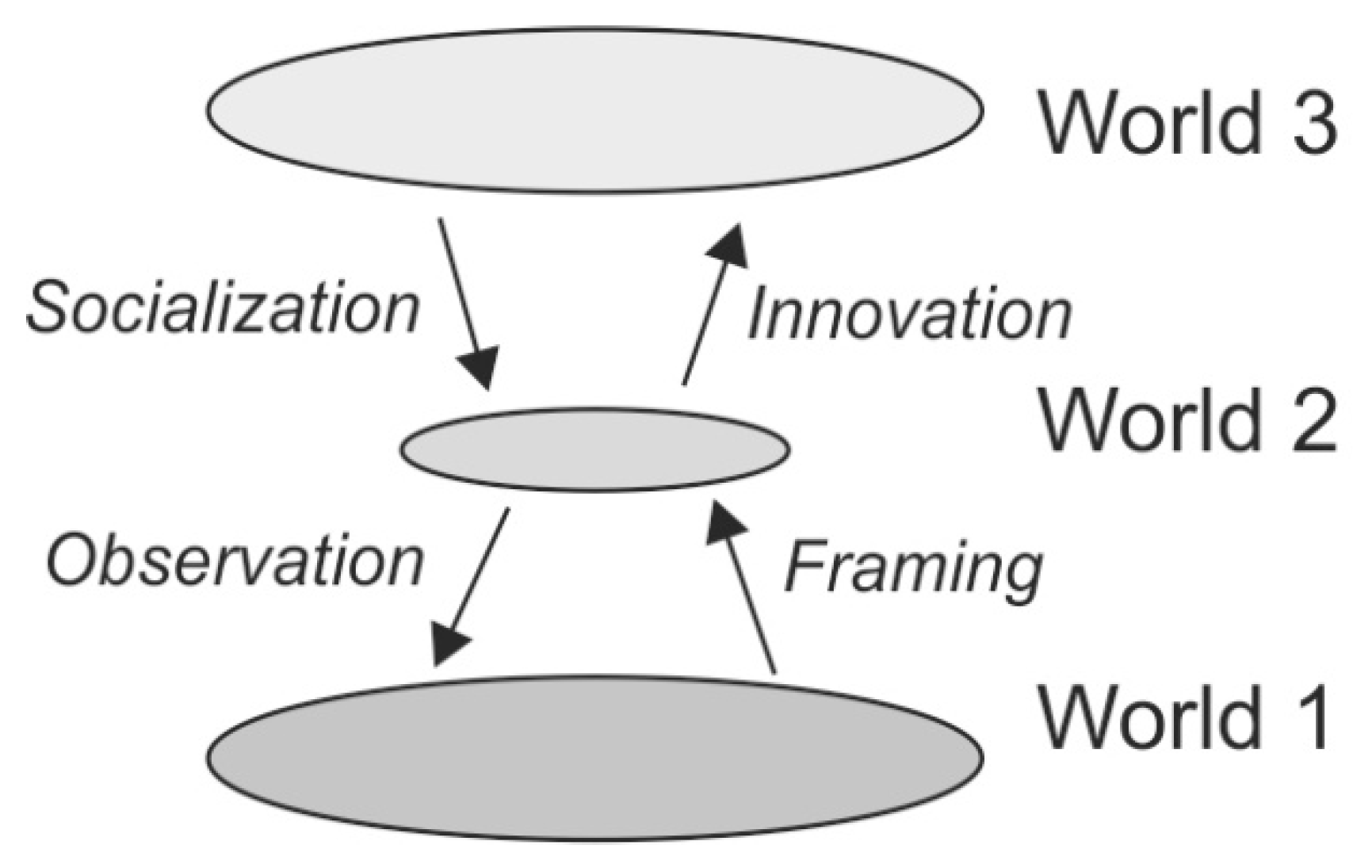
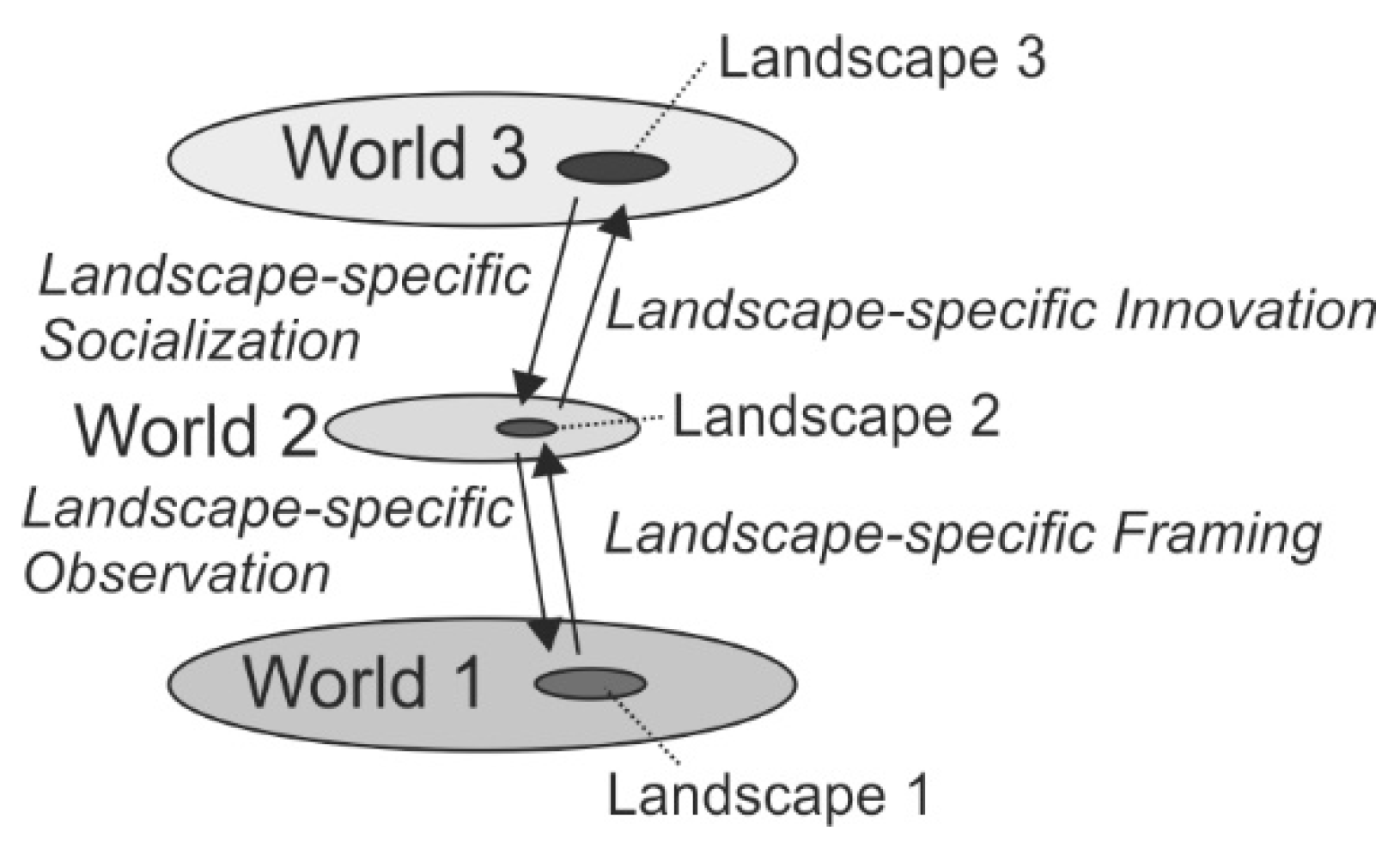
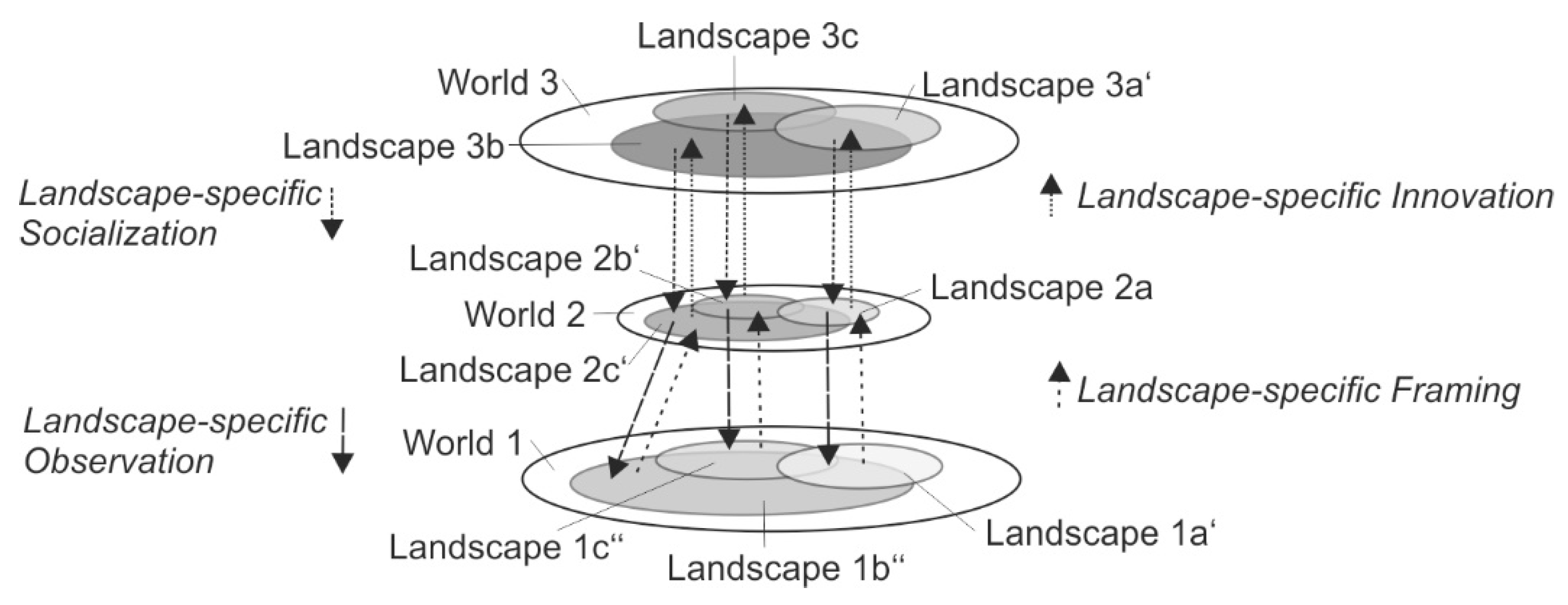
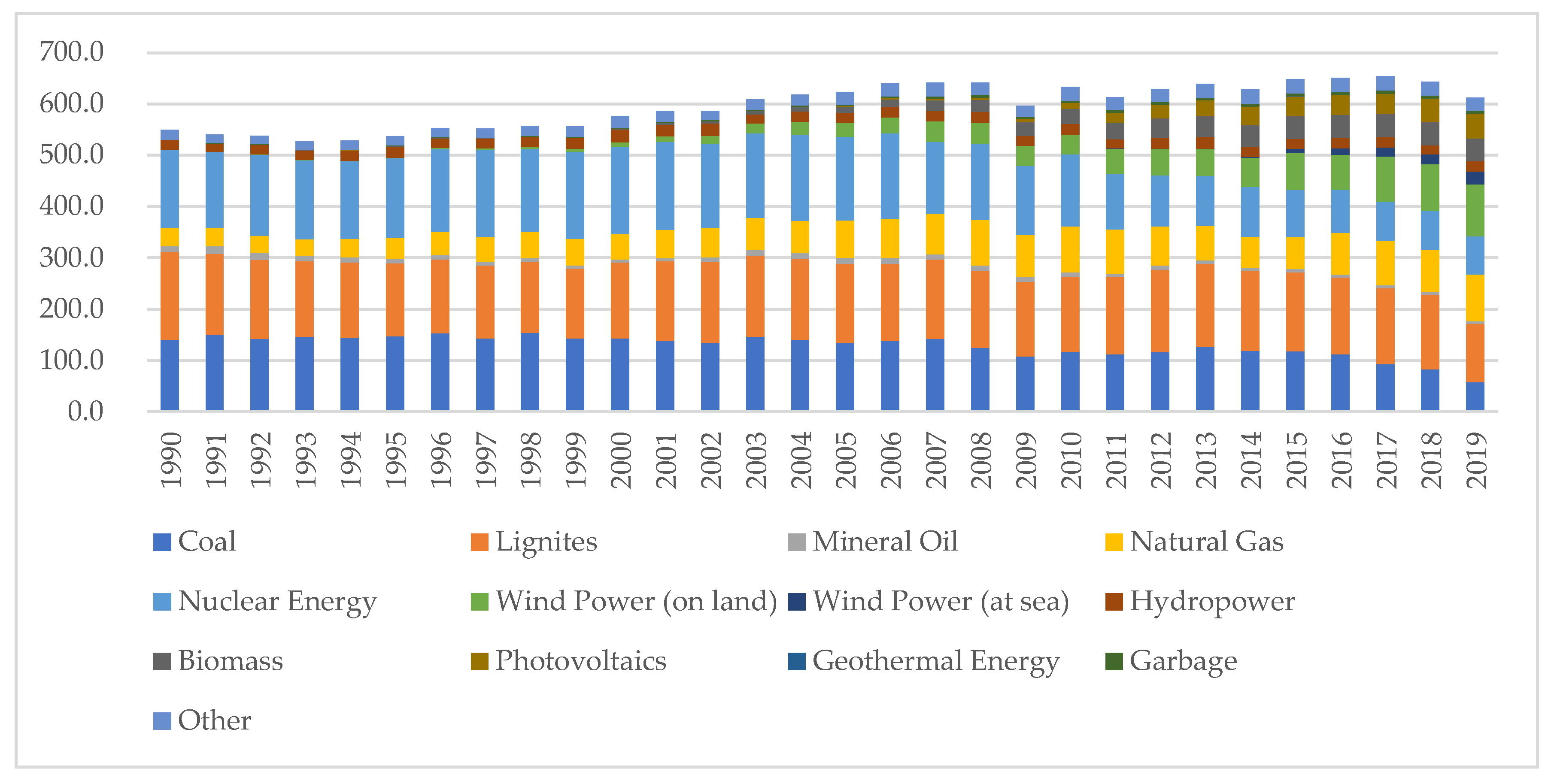
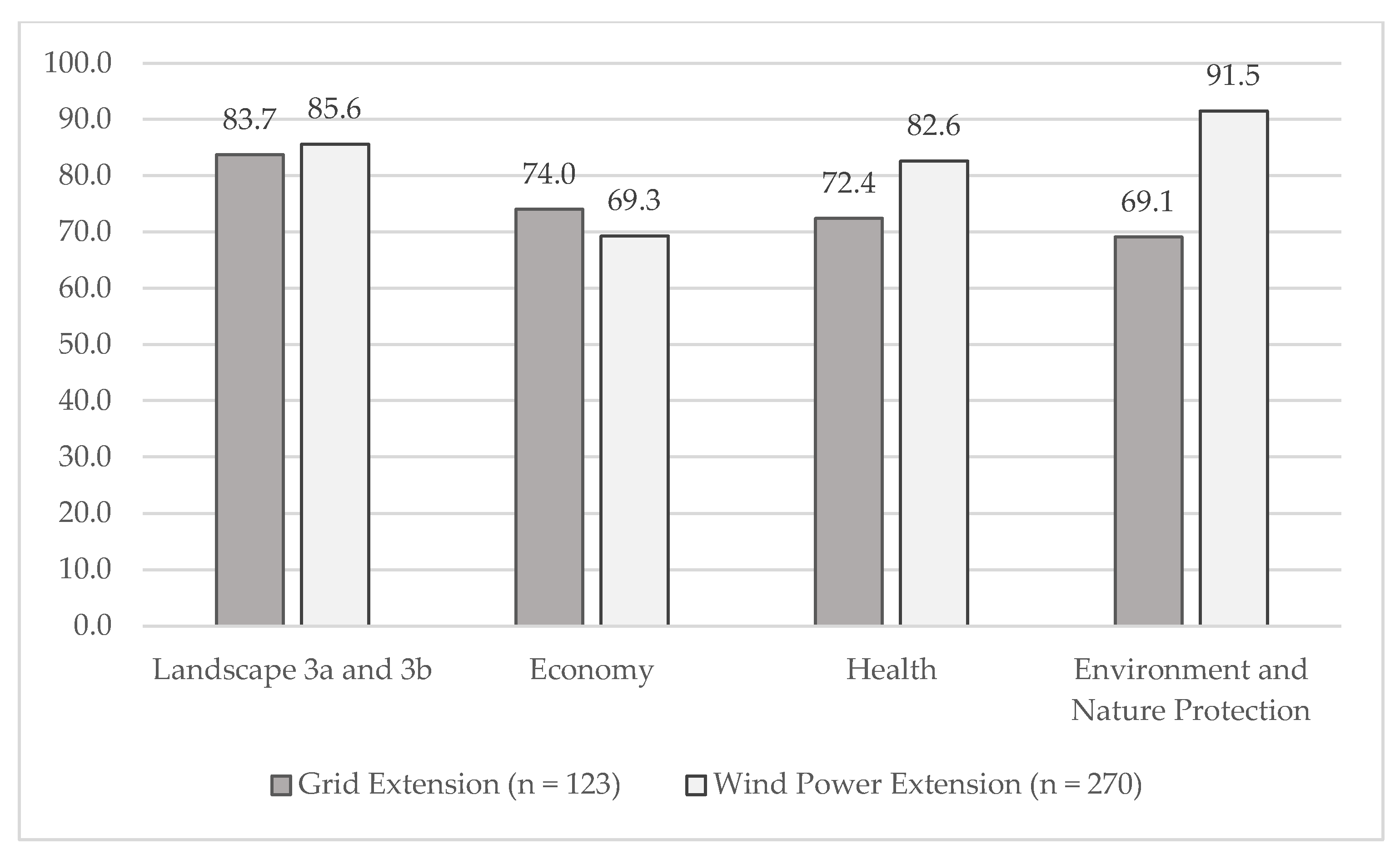

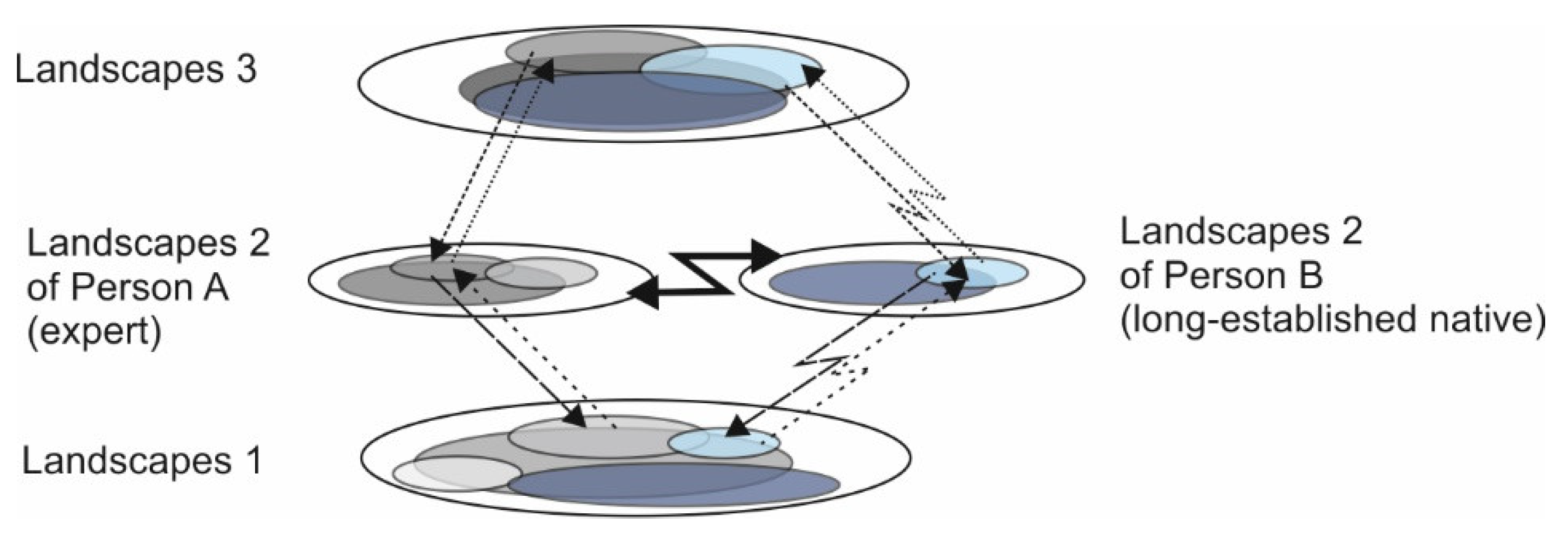
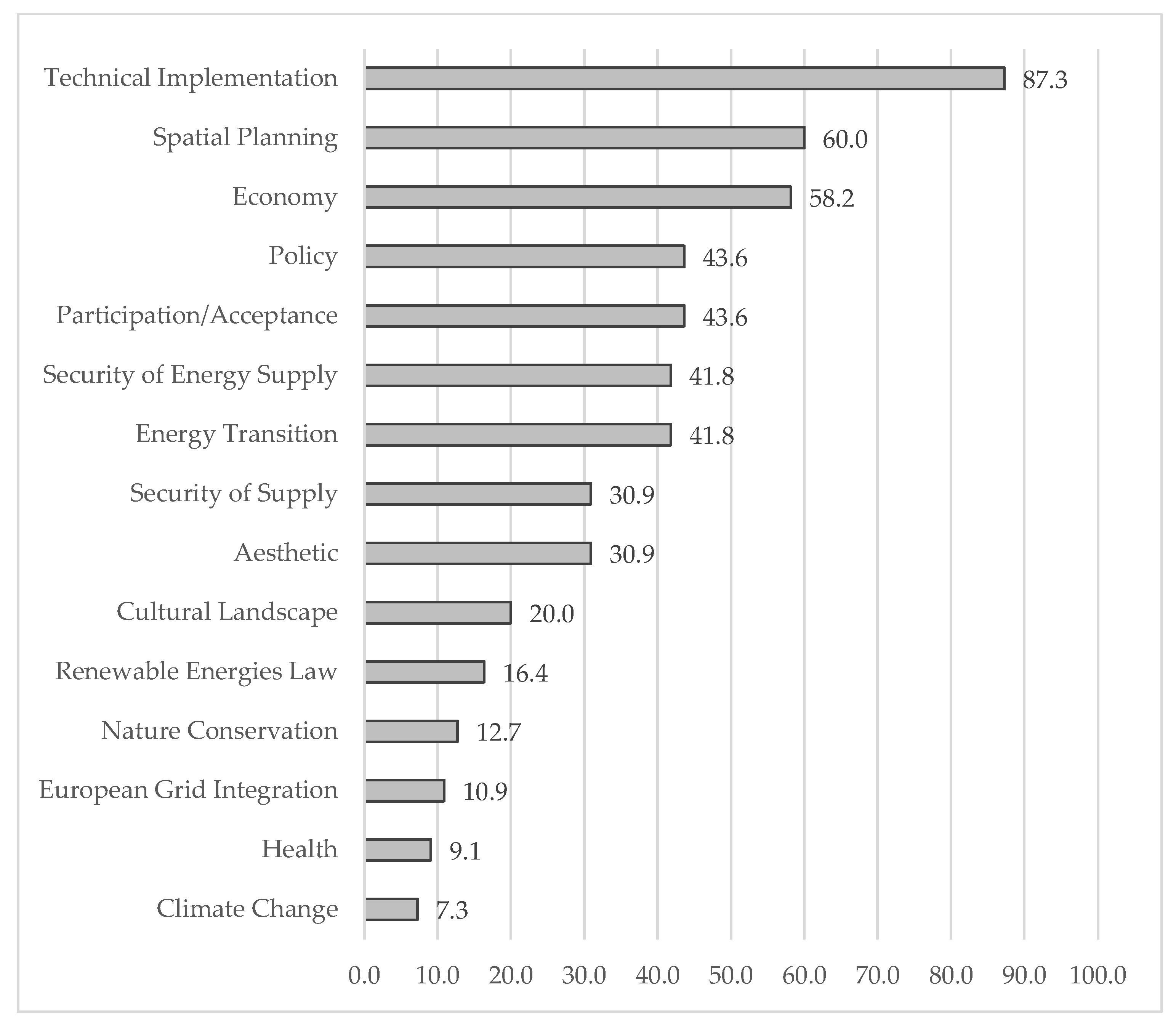
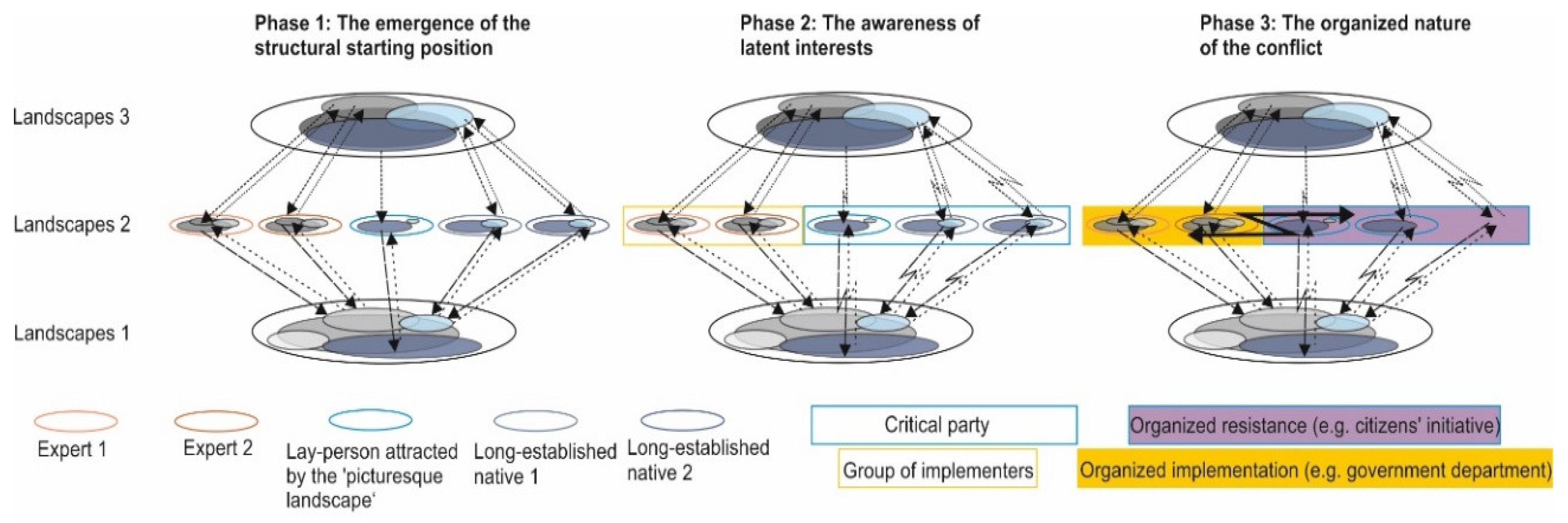

© 2020 by the author. Licensee MDPI, Basel, Switzerland. This article is an open access article distributed under the terms and conditions of the Creative Commons Attribution (CC BY) license (http://creativecommons.org/licenses/by/4.0/).
Share and Cite
Kühne, O. Landscape Conflicts—A Theoretical Approach Based on the Three Worlds Theory of Karl Popper and the Conflict Theory of Ralf Dahrendorf, Illustrated by the Example of the Energy System Transformation in Germany. Sustainability 2020, 12, 6772. https://doi.org/10.3390/su12176772
Kühne O. Landscape Conflicts—A Theoretical Approach Based on the Three Worlds Theory of Karl Popper and the Conflict Theory of Ralf Dahrendorf, Illustrated by the Example of the Energy System Transformation in Germany. Sustainability. 2020; 12(17):6772. https://doi.org/10.3390/su12176772
Chicago/Turabian StyleKühne, Olaf. 2020. "Landscape Conflicts—A Theoretical Approach Based on the Three Worlds Theory of Karl Popper and the Conflict Theory of Ralf Dahrendorf, Illustrated by the Example of the Energy System Transformation in Germany" Sustainability 12, no. 17: 6772. https://doi.org/10.3390/su12176772
APA StyleKühne, O. (2020). Landscape Conflicts—A Theoretical Approach Based on the Three Worlds Theory of Karl Popper and the Conflict Theory of Ralf Dahrendorf, Illustrated by the Example of the Energy System Transformation in Germany. Sustainability, 12(17), 6772. https://doi.org/10.3390/su12176772



